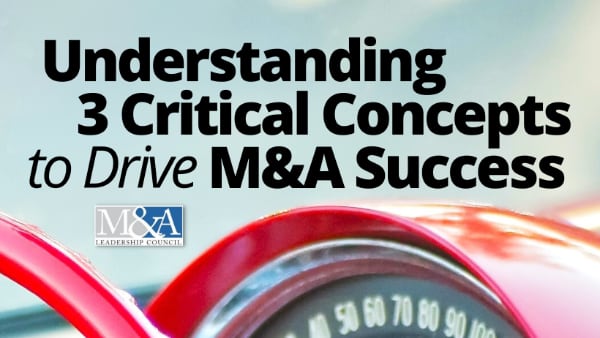
Understanding Value Drivers, Value Creation and Synergies
By M&A Leadership Council
In the landscape of mergers and acquisitions, understanding and harnessing the concepts of value drivers, value creation, and synergies are paramount to the success of any strategic transaction.
Value drivers are the pivotal factors that ground the overall success of an acquisition, encompassing aspects such as revenue and cost synergies, market access, and the acquisition of talent and intellectual property.
Value creation, on the other hand, involves a strategic and deliberate process to enhance the combined worth of the involved entities beyond their individual capabilities.
Synergies, a linchpin in M&A success, represent the harmonious integration of operations, revenue streams, technologies, and cultures, culminating in a unified entity that transcends the sum of its parts.
Following are some nuances of each concept, providing practical insights and illustrative examples to empower your team in orchestrating a seamless and value-driven integration.
VALUE DRIVERS:
Value drivers are the factors that significantly contribute to the overall worth and success of an acquisition. Identifying and leveraging these drivers is crucial for achieving strategic objectives and maximizing returns. Some common value drivers include:
1. Revenue Synergies: Opportunities to increase sales through cross-selling, upselling, or accessing new markets. For example, if your company has a strong presence in North America and the target company excels in European markets, combining forces could create a global sales powerhouse.
2. Cost Synergies: Streamlining operations to eliminate redundancies and achieve cost savings. This could involve consolidating back-office functions, optimizing supply chains, or sharing resources such as IT infrastructure.
3. Market Access: Acquiring new customer segments, distribution channels, or intellectual property that provides a competitive advantage. For instance, if your company lacks a strong online presence, acquiring a target with a robust e-commerce platform could open up new market channels.
4. Talent and Intellectual Property: Acquiring skilled employees, innovative technologies, or proprietary knowledge that enhances your company's capabilities. This might involve bringing on board a team with expertise in a niche area or gaining access to patented technologies.
VALUE CREATION:
Value creation is the process of enhancing the combined worth of the acquiring and target companies beyond what either could achieve independently. To foster value creation, it's important to:
1. Align Strategic Goals: Ensure that the acquisition aligns with your company's long-term objectives and enhances its competitive position. For example, if your goal is to become a leader in sustainable products, acquiring a company known for its eco-friendly innovations supports this strategy.
2. Invest in Integration: Allocate resources and effort to integrate the acquired company seamlessly. This involves cultural integration, systems integration, and aligning business processes to capitalize on synergies.
3. Customer Retention: Maintain focus on retaining key customers by communicating the benefits of the merger and providing consistent service. Loss of customers during integration can erode the anticipated value.
SYNERGIES:
Synergies refer to the additional value generated by the combined companies that exceeds the sum of their individual values. There are various types of synergies, including:
1. Operational Synergies: Streamlining operations to reduce costs and improve efficiency. For instance, combining manufacturing facilities or sharing research and development resources.
2. Revenue Synergies: Expanding product offerings, entering new markets, or leveraging each other's customer bases to drive increased sales.
3. Technological Synergies: Integrating complementary technologies to create a more robust and innovative product or service portfolio.
4. Cultural Synergies: Ensuring a smooth cultural fit between the two organizations to minimize disruption and promote collaboration.
A successful acquisition involves identifying and leveraging value drivers, actively creating value through strategic alignment and integration efforts, and capitalizing on synergies to achieve a combined entity that is greater than the sum of its parts. Effective communication, thorough planning, and disciplined execution are key elements in realizing the full potential of an M&A transaction.
-----------------------------------------------------------------------
Learn more about value drivers, value creation, synergies and other aspects of the M&A lifecycle at any of our upcoming virtual or in-person training courses, where you'll interact with peers in small-group breakout sessions, explore case study deep-dives and absorb the war stories and real-world experiences of working presenters. See our Training Calendar for more details and registration.